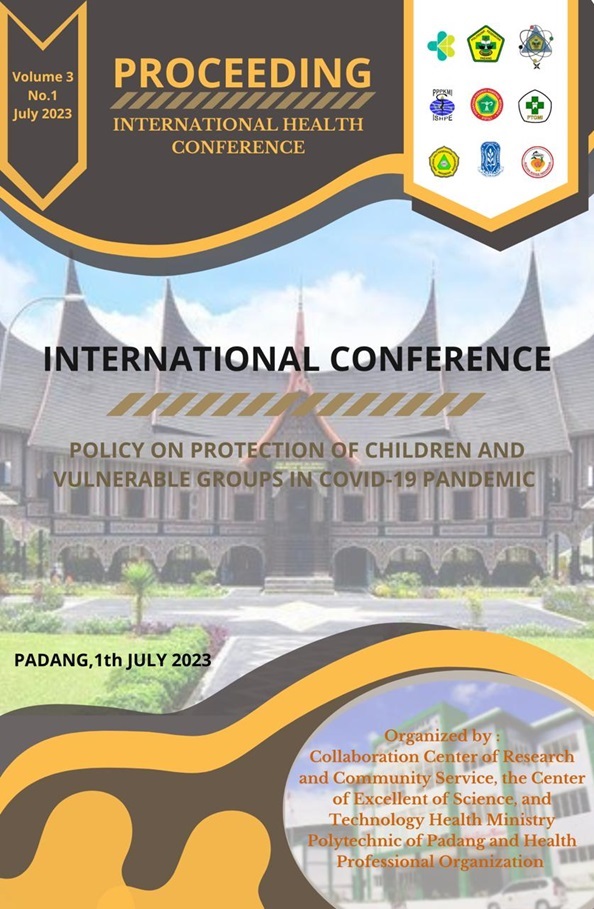Relationship Between Early Breastfeeding Complementary Foods and Mother's Knowledge of Toddler Nutrition with Stunting Incidence at the Ikur Koto Community Health Center, Padang City
Abstract
Background: Stunting (short body) is long-term outcomes of nutrient deficiencies with height according to age less than -2 SD (Standard Deviation) below the median length. Which has an impact on motor and sensory developmental disorders and decreased quality of life. The purpose of this study was to determine the relationship of early breastfeeding supplementation and the level of maternal knowledge about nutrition of toddlers aged 24-36 months to stunting at the Ikur Koto Community Health Center, Padang City.
Methods: This research is a quantitative study withdesign cross sectional, carried out in the work area of the Ikur Koto Community Health Center from January 2019 to August 2019. The sample in this study was mothers who had children aged 24-36 months as many as 80 people. Mothers as respondents were interviewed directly using a questionnaire. The incidence of stunting in children is measured by TB / U indicators and interpreted with software WHO-anthro. Univariate and bivariate data analysis using analysis chi-square (p≤0.05).
The results showed the percentage of stunting was 42.5%. The results of bivariate analysis showed that there was a relationship between early MP-ASI (p = 0.001; OR =8,680; Cl =2,320- 32,476) and maternal nutritional knowledge (p = 0.001; OR =23,864; Cl = 6,879-82,789) with stunting in children. age 24-36 months.
Conclusion: There is a significant relationship between early breastfeeding supplementary nutrition and maternal nutrition knowledge and the incidence of stunting in children aged 24-36 months.
Suggestions: It is expected that efforts to prevent stunting focused in the first 1000 days of life are preventive efforts in detecting stunting events.
Downloads
References
Afrianti, L. (2015). Relationship of Mother's Knowledge about Nutrition and Parenting with the Occurrence of Stunting in Children aged 6-24 months in the Working Area of Nanggalo Health Center in Padang City. Faculty of Public Health, Andalas University.
Agus R. (2008). Relationship between mother's knowledge, attitudes, and actions regarding nutrition with the nutritional status of children under five (1-5 years) in Jorong Surau Laut Work Area of the Biaro Health Center IV Angkek District Agam Regency. Thesis. Padang. Andalas University School of Medicine.
Aridiyah, Farah Okky et al. (2015). Factors that Influence Stunting in Toddlers in Rural and Urban Areas. e-Journal of Health Library, vol. 3 (no. 1) January 2015.
Bloem, M. (2013). Preventing Stunting: Why It Matters, What It Takes. In: Eggersdorfer M, Kraemer K, Ruel M, Biesalski HK, Bloem M et al., Editors. The Road To Good Nutrition. Basel: Karger
West Sumatra Provincial Health Office. (2017). Profile of the 2017 Health Service. Padang:Health Office
Directorate General of Community Nutrition. (2017). Results of Nutrition Status Monitoring (PSG) and Explanation in 2016. RI Ministry of Health. Jakarta
Hermina, N. (2010). Relationship of Breastfeeding Practice Practices with Social Characteristics, Demographics and Information Factors of ASI and MP ASI (Study in Padang City and Solok Regency).Center for Nutrition and Food Development, Research and Development Agency. Ministry of Health
Ibrahim, I, A., R. (2014). Faramita. Relationship between Family Socio-Economic Factors and Occurrence of Stunting Children 24-59 Months in the Work Area of the City of Barombong Health Center Makassar City in 2014. Public Health Science Journal 6 (2) 63-75
Ministry of Health of Republic Indonesia. (2016). Info DATIN (Indonesian Ministry of Health Data and Information Center): Short Toddler Situation. Ministry of Health Republic ofIndonesia. Jakarta.Http://Depkes.Go.Id/Resources/Download/Pusdatin/Infodatin/Situasi-Balita- Short-2016.Pdf.
RI Ministry of Health. (2018). Indonesian Health Profile 2017. Jakarta: Ministry of Health Republic Indonesia of Ministry of Health Republic of Indonesia. 2018. Basic Health Research. Ministry of Health.Jakarta.
Lestari, W., A. Margawati and MZ Rahfiludin. (2014). Risk factors for stunting in children aged 6- 24 months in Penanggalan Subulussalam, Aceh Province. Jurnal Gizi Indonesia 3(1): 37-45
Molika, E. (2014). Variasi Resep Makanan Bayi. Jakarta: Kunci Aksara
Mufida, L, dkk. (2015). Prisip dasar makanan pendamping Air Susu Ibu (MP ASI) untuk bayi usia 6-24 bulan. Jurnal Pangan dan Agroindustri 3(4): 1646-1651. Universitas Brawijaya. Malang
Ni'mah, K. dan SR Nadhiroh. (2015). Faktor yang Berhubungan dengan Kejadian Stunting pada Balita. Media Gizi Indonesia 1(1) : 13-19
Oktarina, Z., and T. Sudiarti. (2013). Risk Factors Stunting in Toddlers (24-59 Months) in Sumatra.
Jurnal Gizi dan Pangan, November 2013, 8(3): 175-180.
Picauly, I. dan S. K, Toy. (2013). Analisis Determinan dan Pengaruh Stunting terhadap Prestasi Belajar Anak Sekolah di Kupang dan Sumba Timur, Ntt:Jurnal Gizi dan Pangan 8(1): 55—62.
Pormes, WE, Rompas S., Ismanto AY (2014). Hubungan Pengetahuan Orang Tua Tentang Gizi dengan Stunting Pada Anak Usia 4-5 Tahun di TK Malaekat Pelindung. Universitas Sam ratulangi : Manado.
Prawesti, DR. (2016). Hubungan Pemberian Makanan Pendamping ASI ( MP-ASI) Dini dengan Status Gizi pada bayi Usia 1-6 Bulan di Puskesmas Lembayan Kabupaten Magetan. Skripsi. Program Studi Keperawatan. Stikes Bhakti Husada Mulia, Madiun
Khasanah, D. P., H.Hadi dan BA Paramashanti. (2016). Waktu Pemberian Makanan Pendamping ASI ( MP-ASI) Berhubungan dengan kejadian stunting anak usia 6-23 bulan di Kecamatan Sedayu. Jurnal Gizi dan Diet Etik Indonesia 4(2): 105-111.
RI Ministry of Health. Jakarta.Kemenkes RI. (2013a). Riset Kesehatan Dasar (RISKESDAS) 2013. Health Research and Development Agency Ministry of Health Republic of Indonesia. Jakarta
Kementrian Kesehatan RI. (2018). Situasi Balita Pendek (Stunting) di Indonesia. Kemenkes.
Jakarta.
TNP2K. (2017). 100 kabupaten/kota prioritas untuk intervensi anak kerdil (stunting) volume 1. Jakarta : Sekretariat Wakil Presiden RI
UNICEF. (2013). The State of the World's Children 2013. [online]. Available:
https://www.unicef.org/sowc2013/files/SWCR2013_ENG_Lo_res_24_Apr_2013.pdf.
World Health Organization (WHO). (2014). WHA Global Nutrition Targets2025:StuntingPolicyBrief.Http://Www.Who.Int/Nutrition/Topics/Globaltarge ts_Stunting_Policybrief.Pdf.
WHO.UNICEF, dan The World Bank. (2017). Levels and Trends in ChildMalnutrition. http://archive.ipu.org/splze/vientiane14/malnutrition.pdf










